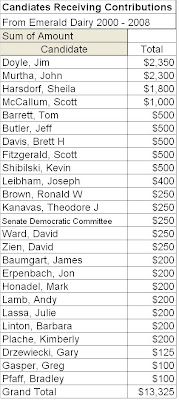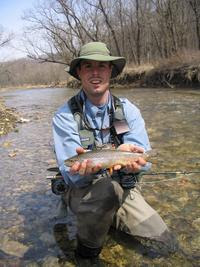2/28/09
What about immigration law reform?
It may be on the back-burner for now but immigration law reform is still a big issue for agriculture and it will return to the forefront.
Click here to play audio interview.
Click here to play audio interview.
Obama proposes phase-out of direct payments to large farms
President Obama’s 2010 budget proposal would, over three years, phase out direct payments to producers with annual revenue exceeding a half-million dollars. A statement issued by the White House says large farmers are well positioned to replace those payments with alternate sources of income from emerging markets for environmental services. On the other hand, American Farm Bureau Congressional Relations Director Tara Smith says $500,000 in annual sales is not that much.
“If you look at soybean farm, for example, that has $500,000 in sales, by the time you take out cost of production, that farmer actually only nets only $36,000.” Smith tells Brownfield from her office in Washington, D.C. “To be nickel and diming those kinds of farmers, we have some significant concerns with that.”
The organization is excited about Obama’s budgeted outlays for Rural Development, says Smith.
The White House says USDA will increase research to encourage the establishment of markets for ecosystem services.
The President wants to maintain a strong safety net for farm families and beginning farmers while encouraging responsibility.
The Obama budget proposal includes a quarter million dollar payment limitation for farmers. The White House says the President intends to close loopholes that allow what it refers to as mega farms to get around payment limits. In his address to Congress Tuesday, Mr. Obama said he would “end direct payments to large agribusinesses that don't need them.”
by Tom Steever
Read more @ Brownfield Network.
“If you look at soybean farm, for example, that has $500,000 in sales, by the time you take out cost of production, that farmer actually only nets only $36,000.” Smith tells Brownfield from her office in Washington, D.C. “To be nickel and diming those kinds of farmers, we have some significant concerns with that.”
The organization is excited about Obama’s budgeted outlays for Rural Development, says Smith.
The White House says USDA will increase research to encourage the establishment of markets for ecosystem services.
The President wants to maintain a strong safety net for farm families and beginning farmers while encouraging responsibility.
The Obama budget proposal includes a quarter million dollar payment limitation for farmers. The White House says the President intends to close loopholes that allow what it refers to as mega farms to get around payment limits. In his address to Congress Tuesday, Mr. Obama said he would “end direct payments to large agribusinesses that don't need them.”
by Tom Steever
Read more @ Brownfield Network.
New regulations require dairies to report emmissions from manure
Many dairies and feedlots are still waiting to feel – maybe a better word in this case is “sniff" – the impact of a new federal regulation on reporting air emissions.
At issue are two major byproducts of cattle operations – emissions of ammonia and hydrogen sulfide. Both gases come from manure. The new Environmental Protection Agency rule went into effect Jan. 20.
All farms are exempt from reporting emissions from animal waste under an environmental law, according to information from the American Farm Bureau Federation. However, under an emergency planning law, concentrated animal feeding operations must report under certain circumstances.
If the facilities’ owners signed the EPA Consent Agreement in 2005 or if the animal population is below 700 dairy cows or 1,000 non-dairy cattle, the operation doesn’t have to report.
Poultry and swine operations also must report if their populations are above specific EPA limits.
Read more @ pntonline.com.
At issue are two major byproducts of cattle operations – emissions of ammonia and hydrogen sulfide. Both gases come from manure. The new Environmental Protection Agency rule went into effect Jan. 20.
All farms are exempt from reporting emissions from animal waste under an environmental law, according to information from the American Farm Bureau Federation. However, under an emergency planning law, concentrated animal feeding operations must report under certain circumstances.
If the facilities’ owners signed the EPA Consent Agreement in 2005 or if the animal population is below 700 dairy cows or 1,000 non-dairy cattle, the operation doesn’t have to report.
Poultry and swine operations also must report if their populations are above specific EPA limits.
Read more @ pntonline.com.
2/26/09
Immigrants an increasingly important labor force in Wisconsin dairy
Immigrants - primarily Mexicans - have become a major source of labor on Wisconsin's dairy farms, according to a new report that studied the issue for the first time.
More than 40% of all hired dairy employees are immigrants, who play an increasingly important role in the industry, according to "Changing Hands: Hired Labor on Wisconsin Dairy Farms." These new workers are also changing the demographics of rural communities and presenting opportunities and challenges for the industry, said the report, which was prepared by principal researcher Jill Harrison, an assistant professor in the department of rural sociology at the University of Wisconsin-Madison.
"Most people I talk to are very surprised that Latinos are quickly becoming the majority of the work force on dairy farms," Harrison said.
Researchers held focus groups with dairy farmers, surveyed 83 farm owners and 370 of their employees, and followed up with more in-depth interviews, she said.
They found that dairy farmers here began hiring immigrant workers around 2000. Of course, immigrants have been coming to the Midwest to pick vegetables and other seasonal crops since the 1930s and working in meatpacking and food processing plants throughout the 20th century, she said. The study estimates that in 2007 at least 12,551 people were hired to work on Wisconsin dairy farms and at least 5,315 were immigrants. The study cites various reasons for the changes, including:
• Farmers are increasing production to increase income, and larger herds mean more workers are needed to keep the three-times-a day milking schedule.
• Tighter budgets may drive more farm families to work off the farm to stabilize the family income and/or for health insurance.
• Farm families are shrinking, and spouses and farm children often go off the farm to build careers.
Other reasons include the increasing average age of farmers.
Read more @ Milwaukee Journal.
More than 40% of all hired dairy employees are immigrants, who play an increasingly important role in the industry, according to "Changing Hands: Hired Labor on Wisconsin Dairy Farms." These new workers are also changing the demographics of rural communities and presenting opportunities and challenges for the industry, said the report, which was prepared by principal researcher Jill Harrison, an assistant professor in the department of rural sociology at the University of Wisconsin-Madison.
"Most people I talk to are very surprised that Latinos are quickly becoming the majority of the work force on dairy farms," Harrison said.
Researchers held focus groups with dairy farmers, surveyed 83 farm owners and 370 of their employees, and followed up with more in-depth interviews, she said.
They found that dairy farmers here began hiring immigrant workers around 2000. Of course, immigrants have been coming to the Midwest to pick vegetables and other seasonal crops since the 1930s and working in meatpacking and food processing plants throughout the 20th century, she said. The study estimates that in 2007 at least 12,551 people were hired to work on Wisconsin dairy farms and at least 5,315 were immigrants. The study cites various reasons for the changes, including:
• Farmers are increasing production to increase income, and larger herds mean more workers are needed to keep the three-times-a day milking schedule.
• Tighter budgets may drive more farm families to work off the farm to stabilize the family income and/or for health insurance.
• Farm families are shrinking, and spouses and farm children often go off the farm to build careers.
Other reasons include the increasing average age of farmers.
Read more @ Milwaukee Journal.
2/25/09
Your Tax Dollars Go To Big Local Farms

According to the Wisconsin Democracy Campaign...
The taxpayers are getting milked by corporate farms.
...Department of Commerce aid to farms and dairy operations totaled $16.6 million in grants, low-interest loans and tax credits to 633 recipients – averaging $26,285 each –between 1999 and mid-2004.
The programs helped only a sliver of Wisconsin’s 16,000 farm operations.
Per capita, contributors again received strikingly larger awards than non-contributors. Non-contributors, who numbered 613, or 97 percent, received $12.7 million in awards – averaging $20,702 apiece.
Meanwhile, the remaining 20 recipients, or 3 percent who made $25,472 in campaign contributions, received about $3.9 million or an average $197,387 apiece – nearly 10 times more than the awards to non-contributors...

...In addition to the disparity between contributors and non-contributors, corporate farms, like large corporations, got a bigger boost from the state than small operators. A large chunk of the grants and low-interest loans that Commerce Department programs doled out to farmers between 1999 and mid-2004 went to several corporate farms. Those operations, which have 700 or more animals, are often criticized for their adverse impacts on air and water quality and the survival of the typical small family farm.
The state was home to 135 corporate farms as of late 2004. Eighty-six of these farms received federal farm subsidies totaling $27.4 million between 1999 and 2003, and Commerce Department programs helped 48 of them with $6.4 million in low-interest loans and grants. That is about 38 percent of the total $16.6 million in awards doled out to the 633 farms and dairy operations by the department’s programs.
Like large corporations, at least some factory farm owners do not appear to need state aid to buy a large dairy operation. One recipient, James Thompson, received a $337,500 low-interest state loan to buy Thistle Dairy in Winnebago County in 2003. A Commerce Department staff review of the project noted Thompson, who would continue to live with his family on a farm in Northern Ireland, is the largest investor in a 2,700-cow farm in Michigan and an individual "with significant net worth."
To follow the money, read more at the
Wisconsin Democracy Campaign.
Below is the list of the four CAFO currently permited to operate in St. Croix County.
The Wisconsin Democracy Campaign also provide tracking on were campaign contributions come from. The local CAFO's are very active in providing contributions to a variety of state politicans from Govenor Doyle to 30th Assembly Representative John Murtha and 10 District Senator Shelia Harsdorf.
Here's a contributions made on behalf of Emerald Dairy.
Below is a summary of the amounts made by individuals claiming Emerald Dairy as their employer:
Below is a summary made to candidates by individuals claiming Emerald Dairy as their employer:
"Living a Nightmare: Animal Factories in Michigan"
A 24-minute documentary about the horrors of industrial agriculture in Michigan.
To watch video click here.

Coming to a western Wisconsin township soon?
The Concentrated Animal Feeding Operation (CAFO or factory farm) has destroyed a way of life and devastated their property value. No-one in their right mind would want to live next to one.
To watch video click here.

Coming to a western Wisconsin township soon?
The Concentrated Animal Feeding Operation (CAFO or factory farm) has destroyed a way of life and devastated their property value. No-one in their right mind would want to live next to one.
Subscribe to:
Comments (Atom)



